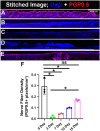Quantifying innervation facilitated by deep learning in wound healing
- PMID: 37803028
- PMCID: PMC10558471
- DOI: 10.1038/s41598-023-42743-5
Quantifying innervation facilitated by deep learning in wound healing
Abstract
The peripheral nerves (PNs) innervate the dermis and epidermis, and are suggested to play an important role in wound healing. Several methods to quantify skin innervation during wound healing have been reported. Those usually require multiple observers, are complex and labor-intensive, and the noise/background associated with the immunohistochemistry (IHC) images could cause quantification errors/user bias. In this study, we employed the state-of-the-art deep neural network, Denoising Convolutional Neural Network (DnCNN), to perform pre-processing and effectively reduce the noise in the IHC images. Additionally, we utilized an automated image analysis tool, assisted by Matlab, to accurately determine the extent of skin innervation during various stages of wound healing. The 8 mm wound is generated using a circular biopsy punch in the wild-type mouse. Skin samples were collected on days 3, 7, 10 and 15, and sections from paraffin-embedded tissues were stained against pan-neuronal marker- protein-gene-product 9.5 (PGP 9.5) antibody. On day 3 and day 7, negligible nerve fibers were present throughout the wound with few only on the lateral boundaries of the wound. On day 10, a slight increase in nerve fiber density appeared, which significantly increased on day 15. Importantly, we found a positive correlation (R2 = 0.926) between nerve fiber density and re-epithelization, suggesting an association between re-innervation and re-epithelization. These results established a quantitative time course of re-innervation in wound healing, and the automated image analysis method offers a novel and useful tool to facilitate the quantification of innervation in the skin and other tissues.
© 2023. Springer Nature Limited.
Conflict of interest statement
The authors declare no competing interests.
Figures





Update of
-
Quantifying innervation facilitated by deep learning in wound healing.bioRxiv [Preprint]. 2023 Jun 14:2023.06.14.544960. doi: 10.1101/2023.06.14.544960. bioRxiv. 2023. Update in: Sci Rep. 2023 Oct 6;13(1):16885. doi: 10.1038/s41598-023-42743-5. PMID: 37398108 Free PMC article. Updated. Preprint.
-
Quantifying innervation facilitated by deep learning in wound healing.Res Sq [Preprint]. 2023 Jul 3:rs.3.rs-3088471. doi: 10.21203/rs.3.rs-3088471/v1. Res Sq. 2023. Update in: Sci Rep. 2023 Oct 6;13(1):16885. doi: 10.1038/s41598-023-42743-5. PMID: 37461461 Free PMC article. Updated. Preprint.
References
-
- Kähler CM, Herold M, Reinisch N, Wiedermann CJ. Interaction of substance P with epidermal growth factor and fibroblast growth factor in cyclooxygenase-dependent proliferation of human skin fibroblasts. J. Cell. Physiol. 1996;166(3):601–608. doi: 10.1002/(SICI)1097-4652(199603)166:3<601::AID-JCP15>3.0.CO;2-9. - DOI - PubMed
Publication types
MeSH terms
Grants and funding
LinkOut - more resources
Full Text Sources
Miscellaneous

